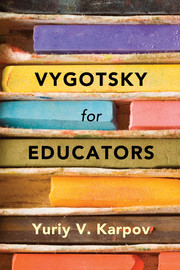Book contents
- Frontmatter
- Dedication
- Contents
- List of Figures
- Acknowledgments
- Introduction
- Part I Mediation from Birth through Adolescence
- 1 The Vygotskian Notion of Mediation as the Major Determinant of Children’s Learning and Development
- 2 First Year of Life
- 3 Second and Third Years
- 4 Three- to Six-Year-Olds
- 5 Mediation of Preschoolers’ Activities to Promote School Readiness
- 6 Learning at School: Children Not Only Learn; They Develop As Well
- 7 Understand Adolescents and Make a Difference!
- Part II School: What to Teach and How to Teach
- Notes
- Index
3 - Second and Third Years
From Object-Centered Explorations to Exploration of the World of Social Roles and Relationships
Published online by Cambridge University Press: 05 June 2014
- Frontmatter
- Dedication
- Contents
- List of Figures
- Acknowledgments
- Introduction
- Part I Mediation from Birth through Adolescence
- 1 The Vygotskian Notion of Mediation as the Major Determinant of Children’s Learning and Development
- 2 First Year of Life
- 3 Second and Third Years
- 4 Three- to Six-Year-Olds
- 5 Mediation of Preschoolers’ Activities to Promote School Readiness
- 6 Learning at School: Children Not Only Learn; They Develop As Well
- 7 Understand Adolescents and Make a Difference!
- Part II School: What to Teach and How to Teach
- Notes
- Index
Summary
As discussed, by the end of the first year of life, infants develop a strong interest in object-centered explorations. This interest, in particular, reveals itself in the fact that infants start spending much time on shaking, taking apart, and throwing different objects, putting small objects into different holes, opening and closing boxes, and so forth. To be sure, these manipulations help infants understand physical properties of objects, such as size, shape, and weight, and the ways these objects behave in different situations (e.g., a ball will roll away if kicked). The Vygotskians, however, argue that these manipulations are not those that are the most important for infant development. Indeed, when manipulating objects in accordance with their physical characteristics, children, strictly speaking, do not need adult help: Physical characteristics of objects are surface, visible, and can be revealed in the course of independent explorations. For example, children can discover by themselves that a ball rolls away if kicked, or that a rattle makes a sound if shaken. Therefore, children’s independent explorations do not create a context for joint child-adult activity and, accordingly, do not provide an opportunity for adults to mediate children. In Vygotsky’s terms, children engaged in independent explorations are performing at the actual rather than proximal level of development of their mental processes.
During the second and third years of life, however, infants become more and more engaged in another type of object-centered explorations: actions with objects in accordance with their social meanings, which include, but are not limited to, children’s play actions with different toys. For example, whereas a younger infant would bang a spoon on the table, an older one would use a spoon to eat. Or, whereas a younger infant would shake or suck a doll, an older one would feed it. According to the Vygotskians, these are the actions that become the most important for infants’ development during the second and third years of life. Indeed, when mastering actions with objects in accordance with their social meanings, children are in need of adult help: As opposed to physical characteristics of objects, their social meanings are not obvious, are not “written” on objects, and, therefore, cannot be discovered by children independently.
- Type
- Chapter
- Information
- Vygotsky for Educators , pp. 44 - 58Publisher: Cambridge University PressPrint publication year: 2014

